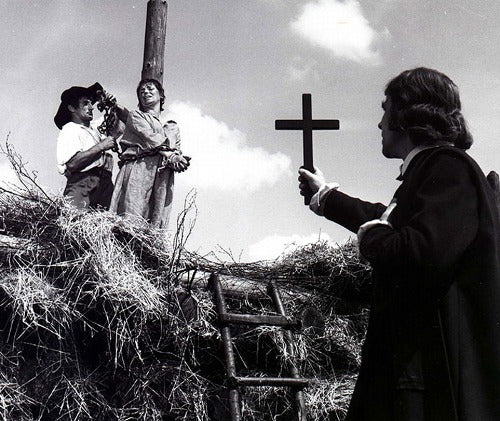Kladivo na čarodejnice (The WitchHammer) - Otakar Vávra (1969)
A film review by Max Leonard Hitchings
Kladivo na čarodejnice is based on the Northern Moravian witch trials that occurred in Velké Losiny and the Šumperk area between 1678 and 1695. The film is adapted from the 1963 novel of the same name by Václav Kaplický.
“Christopher, these days anyone who stands up for heretics is considered a heretic himself”
- Kaspar Hutter
The Opening
Kladivo na čarodejnice (The Witches' Hammer or The Witchhammer) begins with ominous, pounding drums and a song about death: “The Reaper is among us” over a still image of Goya’s 1799 etching El sueño de la razón produce monstruos (The Sleep of Reason Produces Monsters).
After the song, the first line of dialogue is this:
“Through woman, came sin into the world. Woman is sin.”

We then have a montage beginning with an extreme close up of women bathing, and then:
“The womb of woman is the gateway to hell. Bodily desire is the root of evil, in woman insatiable.”
The film is not yet three minutes in and yet everything is there already, present in these early scenes, a microcosm of what is to come. Director Otakar Vávra has given us a near perfect opening.
The lines are spat vehemently by a hooded figure shrouded in darkness, a faceless representation of the collective fears and hates of the patriarchy that would subjugate women during this dark period of history.
The bathing women massage each other, laugh, eat apples and anoint themselves with oils while serene choral music plays, perhaps the last few moments of tranquility and happiness they will experience.
As the hooded figure reminds us, “The embrace of woman is like unto the snares of the hunter. Woman works her trickery with the devil who appears in the form of a man.”

Blasphemy
We then see elderly, poor and sick people begging on the steps of a catholic church. Inside the church, a service is in progress. When it comes time for the eucharist, we see one of the elderly women coming to the pew, however when it’s her turn to receive the body of Christ, she spits it out and then hides the wafer in a napkin and sequesters it among her person - an act of blasphemy that would be completely intolerable to the church if she were to be discovered. Unfortunately for her, an altar boy sees and tells one of the priests. She is taken into the sacristy, where she is questioned by the reverend. What was she doing, stealing the wafer like that? Well, the woman explains that it is for a Mrs. Grör, whose cow won’t milk. The reverend sends for the sherif.
The next thing we see is the Countess de Galle sitting at the head of an opulently spread table, populated with various gentry and clergy. She is clearly excited and states that she has “never seen a witch before”. The reverend explains that it’s not just a matter of one beggar woman, but an entire coven of witches.
The old woman is brought in and explains again that she took the wafer for a woman whose cow won’t give milk and that she was offered a bushel of peas and some barley flour for her troubles. She is asked where Ma Grör got the idea of using the wafer - the answer is from a Ma David, described by the woman as “such an old witch”. When questioned further she explains that this Ma David is a herbalist - she mends brokens arms and works charms on cows.

The Judge
It seems to her ladyship that this old woman doesn’t understand the severity of her crime, however the reverend thinks otherwise - in his opinion the woman is not to be believed. It is the devil speaking, he says, and convinces the countess to hire an inquisition judge - Jindřich Boblig of Edelstadt, played by Vladimír Šmeral.
When Kryštof Alois Lautner (Elo Romančík) goes to find this Boblig, he at first mistakes the man for a simple innkeeper, and a scruffy one at that, and is shocked to find that he is in fact the retired witchfinder whom he was sent to recruit.
Boblig is hired, setting in motion a ghastly series of events.
One by one, the women from the town, most often although not limited to the elderly, are interrogated, tortured in the most shocking of ways and forced to confess to a litany of crimes involving witchcraft - fornicating with spirits on Walpurgis Night, dancing with the devil, kissing demons on the tail and lighting candles at Peter’s Rocks at night in a most unusual way.
When this process accidentally kills one victim, the inquisitors claim that the devil strangled her to prevent her from testifying against him.
Meanwhile, Boblig and his aide are getting fat on the spoils of the inquisition - one gets the impression that they haven’t eaten this well in years. It isn’t just their bellies that are satisfied either, as both use their position to strip, cajole and force themselves on the women in their charge. It is a masterclass in exploitation and manipulation. Soon after Boblig gets started he becomes formidable, the constant threat of accusation hanging in the air effectively allowing him to control the minds of his employers - the clergy and countess.
It isn’t long before Lautner objects to these methods and is of course himself accused of being “present at a witching”.

The Style
Stylistically, Kladivo na čarodejnice stands in stark contrast with something like Sedmikrásky (Daisies), with which it shares a screenwriter in Ester Krumbachová. The latter, a technicolour dream of infinite cinematographic possibilities, was made in 1966 in the lead up to the Prague Spring. Kladivo..., on the other hand, was made in 1970, after that fleeting bubble of liberalism was crushed by the Soviet regime - the film is black and white, slow moving, grim and based very much on a true story - all of the characters were real people who lived and died in terrible circumstances in 17th century Northern Moravia.
Malleus Maleficarum
The Witches’ Hammer AKA Malleus Maleficarum is a real strixological tract written by Heinrich Kramer and first published in Germany in 1487. The book is essentially Witch Trials For Dummies - a nasty how-to guide for would-be inquisitors, with chapter headings like “How Witch Midwives commit most Horrid Crimes when they either Kill Children or Offer them to Devils in most Accursed Wise.” and “Of the Continuing of the Torture, and of the Devices and Signs by which the Judge can Recognize a Witch; and how he ought to Protect himself from their Spells. Also how they are to be Shaved in Parts where they use to Conceal the Devil's Masks and Tokens; together with the due Setting Forth of Various Means of Overcoming the Obstinacy in Keeping Silence and Refusal to Confess.”
The reckless evil of witch trials and mass hysteria that swept across Europe in the 17th century is felt palpably in the film, bringing to mind Häxan (1922), Day of Wrath (1943), Witchfinder General (1968) and Ken Russell’s marvellous fever dream of a film, 1971’s The Devils.
Despite the film’s grounding in historical reality, it must also be read as a product of its sociopolitical context:
The film shows us a slice of the grim reality of tens of thousands of women (and yes, some men), perhaps old or infirm, perhaps simply on the wrong side of the powers that be, who were subjected to the cruelest torture and made to confess to absurd crimes under bogus suspicion of witchcraft. It does not shy away, however, from showing us that the true motivations behind the witch trials (indeed any kind of inquisition) were and will always be fear and control.
Kladivo na čarodejnice surely must therefore be seen also as a most wry allegory of the Soviet state under which the film was made, complete with show trials and unjust execution.

Director Otakar Vávra about Witchhammer:
"After the process with Slánský, I wanted to make a film where I would capture, how it is possible to manipulate and break a person in such a way, that he is begging for his death."
“Already like a black cloud
Death the killer comes riding
On his hunchbacked horse
And the bones of the horse are rattling
And his mildewed mane flows and flows
And with bones and bones he bids us welcome”

